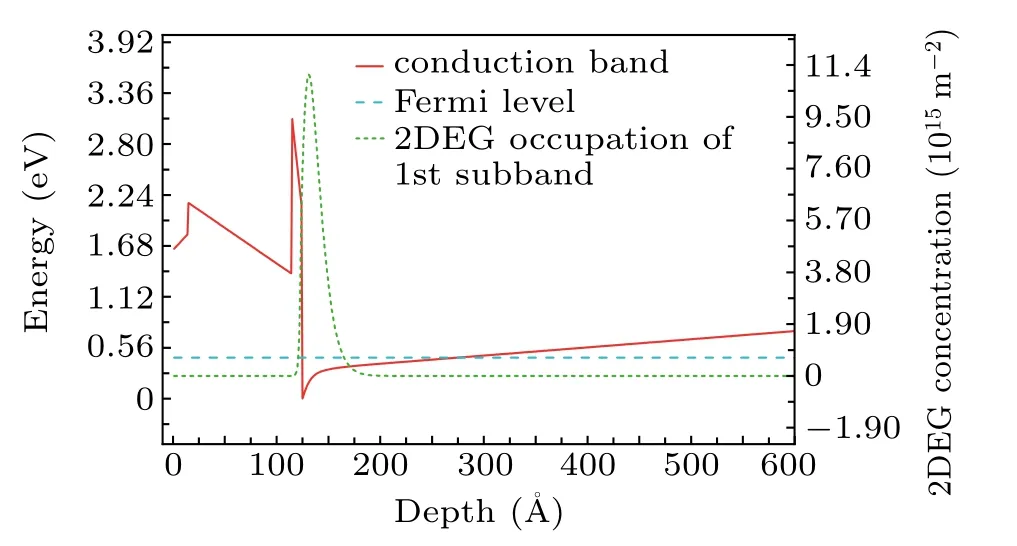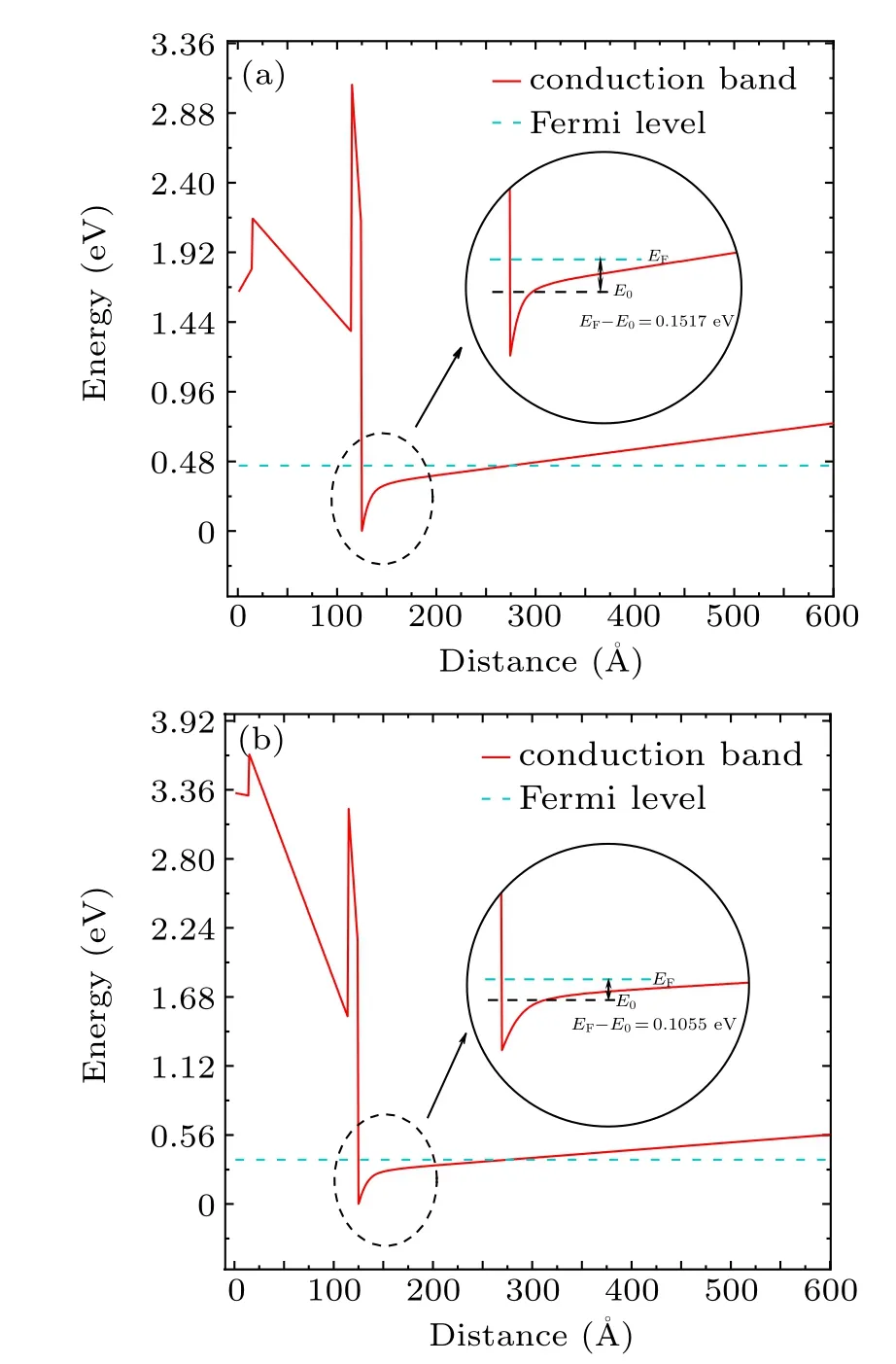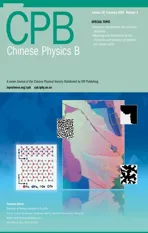Analysis of the decrease of two-dimensional electron gas concentration in GaN-based HEMT caused by proton irradiation∗
2021-03-11JinJinTang汤金金GuiPengLiu刘贵鹏JiaYuSong宋家毓GuiJuanZhao赵桂娟andJianHongYang杨建红
Jin-Jin Tang(汤金金), Gui-Peng Liu(刘贵鹏),2,†, Jia-Yu Song(宋家毓),Gui-Juan Zhao(赵桂娟), and Jian-Hong Yang(杨建红)
1School of Physical Science and Technology,Lanzhou University,Lanzhou 730000,China
2National&Local Joint Engineering Laboratory of Light-conversion Materials and Technology,School of Physical Science and Technology,Lanzhou University,Lanzhou 730000,China
Keywords: proton irradiation,GaN-based HEMT,two-dimensional electron concentration
1. Introduction
Due to the superior material properties such as wide bandgap energy,high thermal and chemical stability,and high displacement threshold energy, GaN-based high electron mobility transistors (HEMTs) exhibit outstanding performance in high power and high frequency applications required in aerospace and military fields. Owing to the spontaneous and piezoelectric polarization in GaN-based HEMT, there is a large interface charge density in this system, which is associated with the formation of the two-dimensional electron gas(2DEG) channel near the AlN/GaN heterointerface. Even in the absence of intentional doping, 2DEG concentration can reach about 1×1013cm−2. In addition, the high mobility of 2DEG gives the GaN-based HEMTs a low on-resistance and perfect high-frequency performance. Inside the earth magnetosphere, there are two Van Allen regions of trapped fast particles, mostly electrons and protons.[1–3]Subjected to the high fluence proton irradiation,the performance of GaN-based HEMTs will degenerate despite its high irradiation tolerance,which has been investigated by many researchers. It has been found that defects produced by proton irradiation can reduce the concentration of 2DEG,[4,5]which in turn causes a shift in threshold voltage and an increase in on-resistance. However,the specific mechanism by which proton irradiation decreases the concentration of 2DEG and affects the band structure of GaN-based HEMTs remains unclear.
Proton irradiation can cause displacement damage and total ionizing dose(TID)radiation effects.[6–8]TID is typically caused by lattice displacement damage caused by ionizing radiation over the integrated exposure time. When GaN-based HEMTs are in operation, electrons and holes introduced by ionization effects can significantly affect the electrical properties of GaN-based HEMT. However, under the equilibrium condition,electrons and holes caused by ionization effects recombine rapidly and have no significant impact on the concentration of 2DEG, which can be ignored. Moreover, previous studies have demonstrated that the ionization effect have no significant contribution to radiation-induced damage in GaNbased devices.[3,6]The other extremely important effect is the displacement damage,which results from nuclear interactions and can lead to lattice defects, i.e., vacancies. Earlier, researchers concentrated on the role of N vacancies on the degeneration of GaN-based HEMTs,[9]and gradually shifted the focus of their researches to Ga vacancies. Lv et al.[5]conducted 3-MeV proton irradiation on AlGaN/GaN HEMTs at fluences of 4×1013cm−2,6×1013cm−2,and 1×1015cm−2,the results suggest that Ga vacancies introduced by proton irradiation may be the main reason for the degradation of GaNbased HEMTs. Further, the energy of proton irradiation was found to be one of the key factors leading to the degradation of the device. Hu et al.[10]reported the effects of proton irradiation on AlGaN/GaN HEMTs at different energies and found that the degradation of GaN-based HEMTs is very small when the energy of proton is greater than 15 MeV.Most of the studies on the degradation of GaN-based HEMTs by proton irradiation have focused on the link between electrical performance degradation and proton irradiation,in contrast to the few studies on the underlying physical mechanisms.
In order to elucidate the physical mechanism by which proton irradiation reduces the 2DEG concentration in GaNbased HEMTs, we develop a model to obtain the simulation results of 2DEG concentration for 100 keV,500 keV,1 MeV,1.8 MeV and 3 MeV proton irradiation on devices with fluences ranging from 1×1011cm−2to 1×1015cm−2. The coupled Schr¨oodinger’s and Poisson’s equations are solved to calculate the band structure and 2DEG concentration by selfconsistency method,[11]in which the vacancy data acquired by SRIM are taken into account. We find that 2DEG concentration decreases significantly after irradiation with 100 keV protons at a fluence of 1×1015cm−2.
2. Modeling
2.1. Proton irradiation simulation with SRIM software
SRIM is a software that simulates the stopping and range of the ions in matter by the Monte Carlo method.[12]As protons pass through the device,they will lose part of their energy,and the lost energy will be transferred to the lattice atoms in the form of non-ionizing energy loss(NIEL),which will displace the atoms from their lattice sites and create charged defect centers, i.e., Ga vacancies (VGa) and N vacancies (VN).VGais an acceptor-like defect, which acts as a compensation center and may be responsible for the carrier removal. For the N vacancies,there have been some research demonstrated that N vacancies as donor-like defects have little effect on the electrical properties of GaN-based HEMTs.[5]Therefore, we only consider VGaas the main factor for the decrease of 2DEG concentration and analyze the physical mechanism behind it.
The structure of the GaN-based HEMT we studied is shown in Fig.1,which consists of four layers: GaN cap layer,AlGaN layer, AlN layer, GaN layer. Vacancy data will be given after the simulation completed, and Ga vacancies density changes with depth as shown in Fig.2. Since the 2DEG is mainly concentrated in the GaN layer about 5 nm near the AlN/GaN interface (as shown in Fig.3), we only consider the vacancies distribution in the 6 nm range in the GaN layer. The energy and fluences of proton irradiation are set to 100 keV,500 keV,1 MeV,1.8 MeV,3 MeV and 1×1011cm−2,1×1012cm−2,1×1013cm−2,1×1014cm−2,1×1015cm−2,respectively.

Fig.1. Schematic device structures of GaN-based HEMT.

Fig.2. Vacancy density vs. proton energy and depth in GaN-based HEMT.The proton fluence is 1×1015 cm−2.
2.2. Calculation of 2DEG concentration
To calculate the concentration of 2DEG, we must solve the coupled Schr¨odinger’s and Poisson’s equations. The parameters we used in this work are shown in Table 1. The electrostatic potential in the GaN-based HEMT is related to charge distribution by Poisson’s equation,


where EFand EAare the Fermi level and acceptor level, respectively; NGais the density of Ga vacancies, and gAis the ground-state degeneracy factor.

Table 1. Material parameters used for the calculations.[15]
For free electrons, the enveloped electron wave function of the i-th subband ψ(i) is determined by the Schr¨odinger equation:

with

where m∗is the effective mass of the electron, and Eiis the eigenenergy of the i-th subband. Among the total potential V(z)are the following terms: a barrier potential VB(z)due to the conduction band offset at the interface; a potential VP(z)resulting from the polarization charge at the interface; a potential VA(z) related to the ionized acceptors; Vel(z) refers to the potential from electrons. Using dichotomy to solve coupled Schr¨odinger’s and Poisson’s equations self-consistently,the conduction band profile,free electron distribution,and the electron eigenstates are obtained. The total concentration of 2DEG is taken in the following form:

where the Fermi level EFsatisfies the following equation under equilibrium condition:[13]

where σGaN, σAlGaNand σAlNare the total polarization charge induced by spontaneous and piezoelectric polarization across the GaN/AlGaN, AlGaN/AlN and AlN/GaN interface, respectively; x represents the composition of Al.∆EC,GaN/AIGaN(x)is the band offset at GaN/AlGaN heterointerface.∆EC,AlGaN/AIN(x)is the band offset at AlGaN/AlN heterointerface. ∆EC,AlN/GaN(x) is the band offset at AlN/GaN heterointerface.[14]NA,barrier(z) is approximately equal to the distribution of VGain the GaN cap layer, AlGaN layer, and AlN layer. The direction of z is perpendicular to the interface and extends inward. Here eΦb(x) is Schottky barrier height,which is given by[15]

So far,we have not considered the distribution of Ga vacancies in the GaN layer. According to the neutrality condition,the ionized Ga vacancies in the quantum well region have little effect on the energy band in the process of self-consistent calculation. Since the Ga vacancy trap electrons in the quantum well, the ionization of the Ga vacancies must lead to a decrease in the 2DEG concentration. The actual 2DEG concentration should be the calculated 2DEG concentration minus the concentration of ionized Ga vacancies, thus nsis denoted as

where ns,calis the concentration of 2DEG by self-consistence calculation. N−A,GaNis the distribution of ionized Ga vacancies in GaN layer.In our calculation,we find that the concentration of 2DEG can be significantly reduced by Ga vacancies in the GaN layer only when the energy and fluence of proton irradiation are 100 keV and 1×1015cm−2,respectively. The reason is that irradiated by protons with high energy and low fluence,the concentration of Ga vacancies in the GaN layer is so small that the electrons trapped by Ga vacancies are negligible compared to the concentration of 2DEG.The conduction band profile before irradiation obtained by solving Schr¨odinger’s and Poisson’s equations self-consistently is shown in Fig.3. The Fermi level is 0.45 eV above the conduction band bottom and the concentration of 2DEG is up to 2.48×1013cm−2.

Fig.3. The conduction band profile of GaN-based HEMT before irradiation,i.e.,energy and 2DEG sheet charge concentration versus depth.
3. Results and discussion
The conduction band profiles and the concentrations of 2DEG near the AlN/GaN interface in GaN-based HEMT irradiated by protons with different fluences and energy are shown in Figs. 4 and 5, respectively. As shown in Fig.5, no significant decrease of 2DEG concentration is observed after proton irradiation at fluence below 1×1013cm−2. When proton fluence rises to 1×1015cm−2, 2DEG concentration decreases significantly at each irradiation energy. For 100 keV proton irradiation,the 2DEG concentration decreases dramatically when the fluence rises to 1×1014cm−2. As shown in Fig.2, 100 keV proton irradiation introduces much more Ga vacancies than the higher energy proton irradiations. The reason is that the proton with low energy will decelerate rapidly when they collide with the lattice atoms,transferring more energy to lattice atoms in the form of NIEL. Apparently, that will create more Ga vacancies, which may be responsible for the decrease of 2DEG concentration.

Fig.4. The conduction band profiles of GaN-based HEMT before irradiation and after proton irradiation with different energy at fluence of 1×1015 cm−2.

Fig.5. The 2DEG concentration vs proton irradiation fluence and energy.
When Ga vacancies ionize as acceptor-like defects,it will capture the electron and become a negative center after ionization. In the GaN cap layer and AlGaN layer, a great number of Ga vacancies ionize,and electrons are trapped in the energy level introduced by Ga vacancies. Meanwhile, as shown in Fig.4,the formation of negative centers in the barrier will also affect the conduction band structure for the reason that ionized Ga vacancy increases the electric field intensity in the AlGaN layer significantly.
When the fluences of proton radiation are increased from 1×1011cm−2to 1×1015cm−2,the 2DEG concentration decreases more sharply at 100 keV proton irradiation compared to the higher energy proton irradiation. There are two reasons:(1)Under 100 keV proton irradiation,there will be much more Ga vacancies introduced by proton irradiation in the quantum well area where the 2DEG is located. (2)The Ga vacancies in the barrier increase significantly, affecting the band structure and the relative position of Fermi level(EF)to the ground-state energy level(E0).

Fig.6. The relative position of the ground-state energy level and the Fermi level(a)before irradiation and(b)after 100 keV proton irradiation at fluence of 1×1015 cm−2.
Clearly, if more Ga vacancies are in the area where the 2DEG is located,the 2DEG concentration will decrease more dramatically due to the ionization of Ga vacancies. Based on Eq. (6), the change of relative position of EFto E0will be a crucial factor in the reduction of the 2DEG concentration. As shown in Fig.6, the value of (EF−E0) decreases from 0.1517 eV to 0.1055 eV after 100 keV proton irradiation,which will reduce the 2DEG concentration by about 30%even if we do not consider the Ga vacancies in the GaN layer,based on our calculation. Under the combined effect of the two mechanisms discussed above,ionized Ga vacancies introduced by proton irradiation are the key factor for the reduction of 2DEG concentration.For the same irradiation fluence,a relatively lower proton irradiation energy will introduce more Ga vacancies and thus reduce the 2DEG concentration more significantly. Therefore,when designing irradiation-resistant devices,special attention should be paid to the effect of low energy protons on the device and the protective structure should be designed.
4. Conclusions
We have investigated the impact of proton irradiation on the 2DEG concentration in GaN-based HEMTs. Considering the defects introduced by proton irradiation, a model has been developed to calculate the 2DEG concentration. The results reveal that Ga vacancies in the GaN layer can trap twodimensional electrons in the quantum well,while Ga vacancies in the AlGaN layer and the GaN cap layer reduce the 2DEG concentration by affecting the energy band structure and the Fermi level. The Ga vacancies in the AlGaN layer and the GaN cap layer take the dominant contribution to the reduction of 2DEG concentration by affecting the Fermi level and ground-state energy level,which is the key mechanism for the reduction of the 2DEG concentration when the fluence of proton irradiation is relatively low. Our calculations show that low-energy proton irradiation will introduce relatively more Ga vacancies inside the device and the concentration of 2DEG will be significantly reduced through the two mechanisms described above.
猜你喜欢
杂志排行
Chinese Physics B的其它文章
- Novel traveling wave solutions and stability analysis of perturbed Kaup–Newell Schr¨odinger dynamical model and its applications∗
- A local refinement purely meshless scheme for time fractional nonlinear Schr¨odinger equation in irregular geometry region∗
- Coherent-driving-assisted quantum speedup in Markovian channels∗
- Quantifying entanglement in terms of an operational way∗
- Tunable ponderomotive squeezing in an optomechanical system with two coupled resonators∗
- State transfer on two-fold Cayley trees via quantum walks∗
